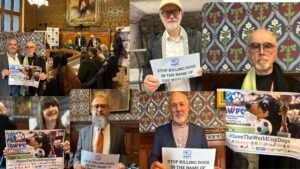Draft Law No. 19.25
Concerning Humane Dog and Cat Care, Welfare and Management
General Secretariat of the Government (Official Printing Press) – Rabat
2025-1447
Scope
This law sets forth the rules for humane dog and cat care and management.
It includes provisions on responsible ownership, setting out duties upon owners to care for their animals properly; and measures to manage stray animal populations humanely and effectively to control their reproduction and spread and to protect them and the public from health, safety and welfare risks.
Preamble
Recognizing that animals, like humans, are sentient beings with biologically determined natures, instincts, emotions and needs which matter to them; as well as the ability to experience pain, fear and to suffer. This provides an ethical responsibility to optimize the welfare of animals to the greatest extent possible.
Recognizing that any modern animal protection and welfare law should be dedicated and geared to meet the following three main requirements: to promote animal welfare, to prevent animal cruelty and to minimize the suffering of animals.
Acknowledging that Morocco is a member of the World Organization for Animal Health (WOAH) and has agreed both their general principles of animal welfare (Terrestrial Animal Health Code Article 7.1) and their dog population management (Terrestrial Animal Health Code, Chapter 7.7, as amended).
Further acknowledging that Morocco is a member of the African Union, which has an Animal Welfare Strategy for Africa (AWSA). This was agreed by the African Union Commission for implementation by its members. It recognizes the need for animals to be treated as sentient beings, to mainstream animal welfare in legislation, including alignment with WOAH standards, and to attain behavioral change.
Acknowledging that in the case of dogs and cats, Catch–Neuter–Vaccinate–Return (CNVR) or equivalent neutering programs are the only sustainable, effective, and humane methods for controlling stray populations. This is in accord with the 2019 order from King Mohammed VI which was agreed with the competent authorities.
Also recognizing the importance of tackling the root causes of the abandonment of stray animals; and that these necessitate the development of humane attitudes and behavior. Thus, provisions have been included on responsible ownership, setting out duties upon the owners of animals to care for those animals properly, together with enforcement mechanisms.
Article 1: Definitions
(a) Animal: For the purposes of this law, “animal” shall mean only dogs and cats, whether kept as pets, owned but roaming, or without an owner.
(b) Animal Welfare: How an animal is coping with the conditions in which it is living. For animal welfare to be satisfactory, the animal must be in a state of overall well-being, which is a condition of physical, mental and emotional harmony, and which includes the ability to live naturally and to meet all species-specific and ethological needs. This would include the provision of the Five Freedoms.
(c) Catch-Neuter-Vaccinate-Return (CNVR): A management strategy in which stray animals are humanely caught, evaluated and sterilized to prevent reproduction (spayed or neutered), vaccinated (against rabies and other diseases as appropriate), and marked to show their sterilization and vaccination status before return to their original location.
(d) Civil Society Organization: A non-governmental, non-profit association recognized by the Competent Authority.
(e) Collective Health Office: (Requires Explanation)
(f) Competent Authority: The ministry, municipality, or other government body designated to implement and enforce the provisions of this law.
(g) Communal Health Preservation Office: (Requires Explanation)
(h) Humane: Treatment of animals that cares for and respects their welfare and sentience.
(i) Owner: Used with reference to the animal, includes not only the owner but also any keeper or any other person for the time being in possession, charge, custody or control of the animal, with or without the consent of the owner.
(j) Sentience: The capacity to perceive or feel things. Sentient beings share with us consciousness, feelings, emotions, perceptions – and the ability to experience pain, suffering, fear, distress and states of well-being.
(k) Stray: For the purposes of this law, this means a dog or cat not under direct control by a person or not prevented from roaming.
There are three types of stray animals:
- Free-roaming owned – not under direct control of, or restriction by, a person/owner at a particular time.
- Free-roaming with no owner or keeper.
- Feral – a domesticated animal having returned to an untamed state after escape from captivity or after abandonment.
(l) Stray Animal Care Center: Any establishment under this law and licensed by the competent authority to provide care, management, neutering, vaccination, adoption, or humane euthanasia for stray animals.
(m) Veterinarian: Veterinary Surgeon who is qualified and licensed under the provisions of the Law.
Chapter One: General Provisions
Article 2
The competent authorities shall work to progressively develop an ethic of care and respect for animals throughout society; in terms of both practical care and protection of animals, and humane attitudes. This will include the development of a modern, comprehensive animal welfare framework law and education and awareness programs, which includes the promotion of adoption of dogs and cats.
Article 3
The owner(s) of animals must ensure the welfare of their animals, by meeting their physical, health and behavioral needs; and alleviating any pain or distress.
With regards to stray animals with no known owners, the competent authorities and citizens shall have a duty to safeguard their welfare. In particular, their safety must be protected from all types of cruelty, suffering, maltreatment, harm, killing, torture, or violence; and they must be safeguarded from contagious diseases. Where direct intervention is not possible by citizens, this duty of care would involve immediate action under this law, through reporting to the relevant authorities and civil society organizations.
In accordance with the internationally agreed World Organization for Animal Health (WOAH) Guiding Principles for Animal Welfare, the “Five Freedoms” (freedom from hunger, thirst and malnutrition; freedom from fear and distress; freedom from physical and thermal discomfort; freedom from pain, injury and disease; and freedom to express normal patterns of behavior) will be used to ensure the satisfactory welfare of animals, and the “Five Domains” (nutrition, environment, health, behavior, and mental state) used to support the systematic scientific assessment of animal welfare.
Where there is any doubt that an animal’s welfare needs can be met, then the “internationally established precautionary principle” must be applied, and the animal’s welfare given precedence.
Explanatory Notes:
CHAPTER 10 – PENALTIES:
As we are unfamiliar with Moroccan income, individual earnings etc., we are unable to judge
what would be a suitable and fair penalty/punishment for offences and violations in Morocco.
Therefore, as it varies from country to country, we have chosen not to comment in detail on
Articles 38 to 51, but instead, offer some guidance on how relevant ‘penalties and
punishments’ are assessed elsewhere.
There is a system of ‘Offence Levels’, based on the seriousness of any violations:
An administrative/legal/interference offence by any person who deliberately or negligently
violates against the provisions of the Articles:
• In minor cases the punishment for such an administrative offence will be classified as
a Level 1 offence.
• In serious cases the punishment for such an administrative offence will be a fine
according to a Level 2 offence.
• For aggravated infringements as well as repeated offences, the fine will be rated as a
Level 3 offence.
(Draft Law 19.25 – Articles 38 to 51 apply)
===============================
Criminally liable violations by any person against the provisions of the Articles:
For example, a person who:
• Kills any sentient animal without a sound justification; or
• Inflicts on any sentient animal:
1) deliberately or out of brutality distress, pain or suffering; or
2) prolonged or repeated distress, pain or suffering.
• Sets any animal on another animal with the intent or which is likely to cause the
sentient animal distress, pain, suffering or injury.
1• Performs an action of a sexual nature on or with an animal.
• Abandons any sentient animal that is unlikely to survive in freedom.
• Fails to sustain an animal with an adequate diet leading to its starvation or omits
to provide an animal with essential veterinary treatment leading to its death.
The above are examples of Level 4 offences where imprisonment is an option – with or without
a fine; and with owners being banned from keeping animals in the future, all in accordance
with an extremely serious Level 4 offence.
(Draft Law 19,25 – Article 39 – This is a Level 4 offence)
(Note: The same penalties shall apply when the offender is a corporate body, company,
establishment or institution (whereby these fines then have to be adjusted and aligned
accordingly).





